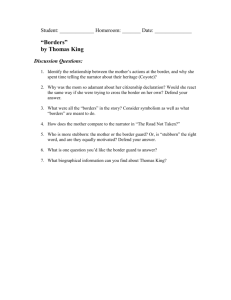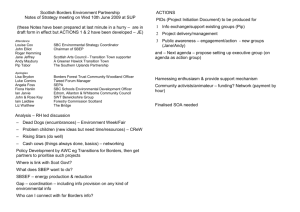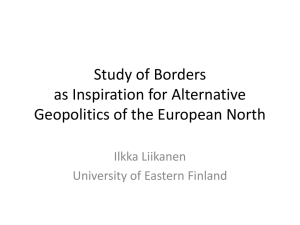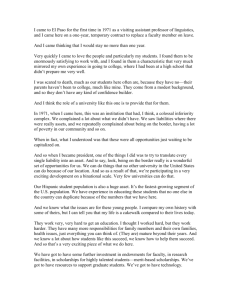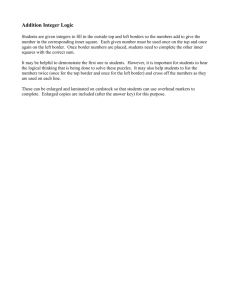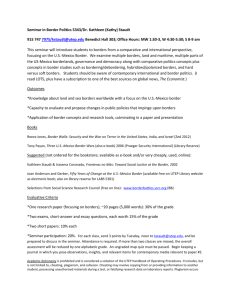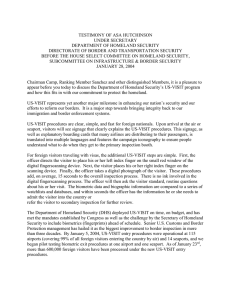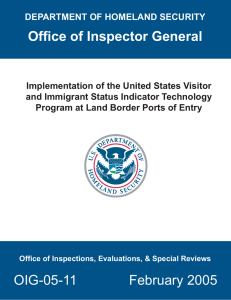Smart borders - National Center for Border Security and Immigration
advertisement
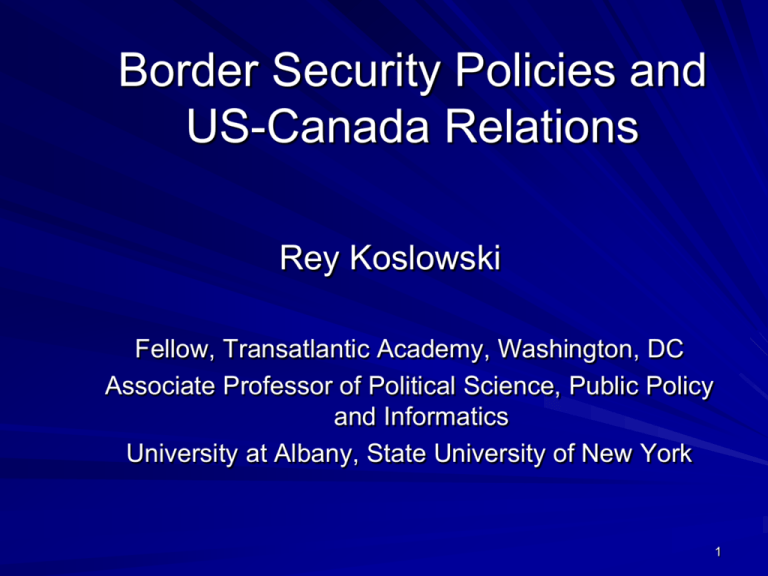
Border Security Policies and US-Canada Relations Rey Koslowski Fellow, Transatlantic Academy, Washington, DC Associate Professor of Political Science, Public Policy and Informatics University at Albany, State University of New York 1 Ambassador Bridge post 9/11/01 2 Smart Borders “The border of the future must integrate actions abroad to screen goods and people prior to their arrival in sovereign U.S. territory. Agreements with our neighbors, major trading partners, and private industry will allow extensive pre-screening of low-risk traffic, thereby allowing limited assets to focus attention on high-risk traffic. The use of advanced technology to track the movement of cargo and the entry and exit of individuals is essential to the task of managing the movement of hundreds of millions of individuals, conveyances, and vehicles” - White House, Jan. 25, 2002 Scenarios for US-Canada border No borders: lift internal border controls after erecting a common external border. Smart borders: increase security and facilitate travel using technology and registered traveler programs Virtual borders: automated data collection, data-mining, biometrics & RFID 4 Presentation outline Possibilities of “no borders” with N.A. perimeter SBInet: physical barriers and a “virtual fence” US-VISIT: automated biometric entry-exit WHITI: passport to enter US Alternatives: security through US-Canada cooperation Proposal: identity management and global mobility 5 No Borders North American Security Perimeter – lifting internal border controls – common external border Presupposes: – customs union – common visa policy 6 Lifting border controls in the EU 1957 Treaty of Rome – committed states to customs union in 12 years 1968 customs union achieved 1986 Single European Act – committed EC states to end non-tariff barriers by 1992 1990 Schengen Convention – harmonizes asylum and visa policies 1993 customs controls at internal borders lifted 1995 all internal border controls lifted 38 years from treaty commitment to customs union to lifting all internal border controls 7 CUBA? Cuban Prime Minister Fidel Castro and Prime Minister Pierre Trudeau join in a singalong during Trudeau's Latin American Tour, January 1976. 8 "I will maintain the embargo. It provides us with the leverage to present the regime with a clear choice.” Barak Obama Miami, Florida May 23, 2008 9 Visa-free travel To US and Canada (35 countries): Andorra, Australia, Austria, Belgium, Brunei, Czech Republic, Denmark, Estonia, Finland, France, Germany, Hungary, Iceland, Ireland, Italy, Japan, S. Korea, Latvia, Lithuania, Liechtenstein, Luxembourg, Malta, Monaco, Netherlands, New Zealand, Norway, Portugal, San Marino, Singapore, Slovakia, Spain, Sweden, Slovenia, Switzerland, United Kingdom Additionally to Canada (17 countries): Antigua and Barbuda, Bahamas, Barbados, Botswana, Cyprus, Greece, Israel, Mexico, Namibia, Papua New Guinea, Poland, St. Kitts and Nevis, St. Lucia, St. Vincent, Solomon Islands, Swaziland, Western Samoa; British dependent territories: Anguilla, Bermuda, British Virgin Islands, Cayman Islands, Falkland Islands, Gibraltar, Montserrat, Pitcairn, St. Helena or the Turks and Caicos Islands; Hong Kong 10 Secure Border Initiative Network (SBInet) “Virtual Fence” US-Canadian Border - Farmed US-Canadian Border Forested 16 Border Patrol apprehending illegal crossers 17 While others cross elsewhere 18 1,349 miles of forested border 19 Fingerscans at consulates & PoEs 22 Table 1: FY 2002 Entries into the US (in millions) Air US Citizens Legal Permanent Residents Visa Waiver Sea 7.4 120.7 161.1 4.4 0.2 75.0 79.6 13.0 0.3 1.8 15.1 52.2 52.2 4.5 28.3 104.1 104.1 358.3 440.4 19.3 4.5 Mexican Border Crossing Card Totals Totals 33.0 Visa Exempt (Canadians) Regular Visa Land 67.9 12.4 Table 2: False Claims to Citizenship To US To other FY1999 FY2000 FY2001 FY2002 27,781 31,964 30,129 15,293 1,108 787 908 836 FY2003 FY2004 12,878 12,404 269 295 Western Hemisphere Travel Initiative (WHTI) Intelligence Reform and Terrorism Prevention Act of 2004 – a valid passport or – documentary proof of citizenship – beginning Jan. 1, 2008 Delayed to June 1, 2009 Jan. 2008: oral declaration of citizenship no longer accepted 25 “Our ID's are the best ID Cards money can buy. They also come with many added security options such as holograms Learn More about Fake ID's” http://www.theidshop.com 26 Pakistani and Polish Passports (genuine) Australian and Philippine Passports (fake) 27 Crossing with fraudulent documents 28 WHTI requirements: June 1, 2009 passport wallet-sized passport card (PASS) Enhanced Drivers’ License (EDL) 29 Personal Authentication Device (PAD) 32 PAD system in action 33 Alternative: Binational inspections Canadians collect data for US-VISIT Binational zones for preclearance European binational cooperation 34 Workplace Enforcement 1997 1998 1999 2000 2001 5.9 M 6.1 M 6.5 M 7.0 M 7.8 M 17,554 13,914 2,849 953 735 485 Indictments 865 1,023 417 178 100 Convictions 778 535 297 180 78 Est. unauthorized population 2002 2003 2004 2005 2006 10.3 M 11.1 M 12 M 445 159 251 716 53 162 66 195 441 13 124 46 188 493 Employer investigations Arrests Identity Management and Global Mobility (a potential research project) UAlbany Center for Technology in Government Identity document fraud – complex problem Examine administrative reforms: – – – – Birth certificate issuance process (US states) Digitization of vital records (US States, Italy) National identity management (UK, Australia) US-VISIT: “biometric data” service provider case studies, best practices NYS agencies 36 Conclusions “No borders” not politically viable “Virtual borders” constrained by infrastructure “Smart borders” can be improved with border infrastructure and/or binational inspections Hope for N.A. perimeter could reduce support for infrastructure budgets and taxes Political capital not infinite; choices necessary 37 Further reading and info: “Smart Borders, Virtual Borders or No Borders: Homeland Security Choices for the United States and Canada.” Law and Business Review of the Americas, Vol. 11, (Summer/Fall 2005). Prepared Testimony for “US-VISIT: Challenges and Strategies for Securing the U.S. Border,” Hearing before the Subcommittee on Terrorism, Technology and Homeland Security of the Committee on the Judiciary, United States Senate, January 31, 2007. Real Challenges for Virtual Borders: The Implementation of US-VISIT, Migration Policy Institute, June 2005. available at: Rey Koslowski’ webpage http://www.albany.edu/~rk289758/ 38
